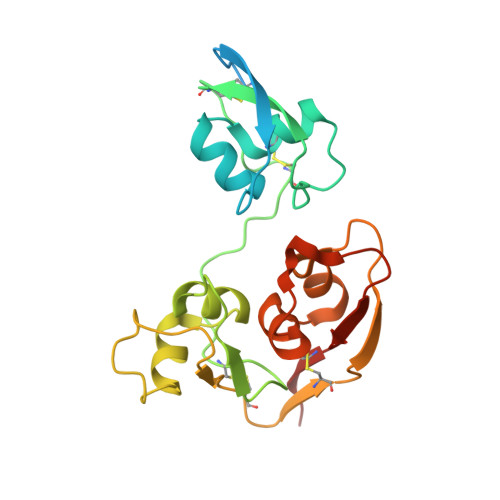Fungal Effector Ecp6 Outcompetes Host Immune Receptor for Chitin Binding Through Intrachain Lysm Dimerization
Sanchez-Vallet, A., Saleem-Batcha, R., Kombrink, A., Hansen, G., Valkenburg, D.J., Thomma, B.P.H.J., Mesters, J.R.(2013) Elife 2: 00790
- PubMed: 23840930
- DOI: https://doi.org/10.7554/eLife.00790
- Primary Citation of Related Structures:
4B8V, 4B9H - PubMed Abstract:
While host immune receptors detect pathogen-associated molecular patterns to activate immunity, pathogens attempt to deregulate host immunity through secreted effectors. Fungi employ LysM effectors to prevent recognition of cell wall-derived chitin by host immune receptors, although the mechanism to compete for chitin binding remained unclear. Structural analysis of the LysM effector Ecp6 of the fungal tomato pathogen Cladosporium fulvum reveals a novel mechanism for chitin binding, mediated by intrachain LysM dimerization, leading to a chitin-binding groove that is deeply buried in the effector protein. This composite binding site involves two of the three LysMs of Ecp6 and mediates chitin binding with ultra-high (pM) affinity. Intriguingly, the remaining singular LysM domain of Ecp6 binds chitin with low micromolar affinity but can nevertheless still perturb chitin-triggered immunity. Conceivably, the perturbation by this LysM domain is not established through chitin sequestration but possibly through interference with the host immune receptor complex. DOI:http://dx.doi.org/10.7554/eLife.00790.001.
- Centro de Biotecnología y Genómica de Plantas , Universidad Politécnica de Madrid , Madrid , Spain ; Laboratory of Phytopathology , Wageningen University , Wageningen , Netherlands.
Organizational Affiliation:



















